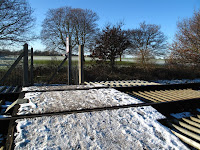Christmas in Peak District country homes was the theme of our weekend out of London. An easy 3 hour drive from London took us to Hardwick Hall, one of three mansions built by Bess of Hardwick.


This remarkable 16th century women was married 6 times, but kept control of her fortune, and began the building of this Hall aged 63, after she got bored with renovating her former home. Hardwick Hall

seems grim by today's standards, but was a formidable project in its day, and a home of luxury; as the abundance of large glazed windows show. Her building project were helped by her interest in architecture and the fact that this very astute business women owned lead mines, quarries and forests. Glazed windows were the new status symbol, so she set up her own glassworks.
The ruined shell of her former home, Hardwick Old Hall, next door to the 'new' one, is also open to the public, as is the nearby water mill.

From here, we did a circular drive, which took in Old Brampton, on the way to Chatsworth, which is another of the homes Bess built. Old Brampton reminded us of the Kipling poem: 'fill the unforgiving minute with 60 seconds worth of distance run' (the motto of our time over here!), as it was included on the circular route because the clock-maker painted 63 minute markers on the dial of the church clock, and that's the way it stays!



From here, the drive took us to Chatsworth, where we enjoyed a circular walk along the stream to Edensor, the fascinating support village for the big house. The 6th Duke had it built with one of each style of house available in the pattern book of the day. After a delicious & huge afternoon tea at the tea rooms, we found there was a floral festival on at the church. This was stunning and delayed us so long, there was only just enough daylight left to finish our walk.

 There was more snow overnight, so we did a 'countryside' walk at Osterley, which is a few train stops short of Heathrow. We had previously done the same walk in the summer of 2001, so it looked rather different today.
There was more snow overnight, so we did a 'countryside' walk at Osterley, which is a few train stops short of Heathrow. We had previously done the same walk in the summer of 2001, so it looked rather different today. The fields were still covered in snow, and part of the walk was along the Grand Union Canal towpath, which was lined with snow, and sections of the canal were frozen. On such a lovely day, it was a perfect way to enjoy what was left of the snow.
The fields were still covered in snow, and part of the walk was along the Grand Union Canal towpath, which was lined with snow, and sections of the canal were frozen. On such a lovely day, it was a perfect way to enjoy what was left of the snow.







































